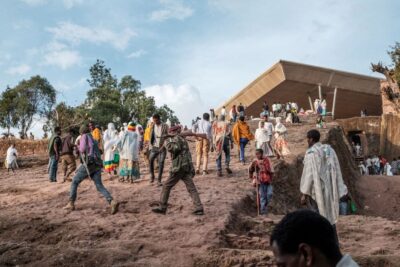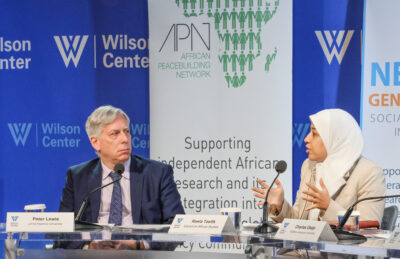Saleem Kureshi’s general store sits at a busy intersection in Mazdoor Colony, a kachi basti (slum settlement) not far from the main train station in Jaipur. Saleem sells basic provisions to residents—wheat, rice, lentils, sugar, and soap. The general store is also a center for local problem solving. When Saleem is not selling provisions, he is acting as a basti neta, or slum leader, assisting residents in securing ration cards and petitioning government officials to improve local conditions. More than a decade of informal leadership has yielded Saleem a large public following in Mazdoor Colony. And, as a party worker for the Indian National Congress (INC), one of India’s national political parties, Saleem is expected to turn this support into votes for the INC during elections.1Names of individuals and settlements have been changed to ensure anonymity.
Party workers like Saleem are influential political actors in India’s slums.2To clarify terms, slum leaders are residents of slums who have gained informal authority within their settlement. A large subset of slum leaders are party workers, with expressed partisan affiliations and positions within party organizations. In India’s slums, “slum leader” (basti neta) and “party worker” (karyakarta) are not synonymous titles. Many, but not all, slum leaders are party workers. For a detailed discussion on these figures and their emergence within settlements, see Adam Auerbach and Tariq Thachil, “How Clients Select Brokers: Competition and Choice in India’s Slums,” American Political Science Review 112, no. 4 (2018): 775–791. They are embedded in hierarchical party networks that stretch from the narrow alleyways of their settlements up to the highest levels of party leadership in the city. For their fellow slum residents, party workers spearhead efforts to fight eviction and demand public services. For political parties, party workers are tasked with persuading and mobilizing voters in their settlements during elections. This intermediary role can be lucrative, providing party workers with election-time party patronage and a daily stream of fees from residents seeking their help.
Party workers operate in the middle of what Javier Auyero calls local “problem solving networks.”3 Durham, NC: Duke University Press, 2001More Info → Such networks are crucial in slums,4Slums are crowded, low-income urban neighborhoods, often with weak or absent formal property rights and marginalized access to public services. Most residents of slums work in the informal sector and depend on tenuous daily wages. Slums are estimated to house more than 65 million people in India, or 17 percent of country’s urban population (Census of India 2011). where residents confront government institutions that are often inhospitable—and violent—toward the poor.5
Durham, NC: Duke University Press, 2001More Info → Such networks are crucial in slums,4Slums are crowded, low-income urban neighborhoods, often with weak or absent formal property rights and marginalized access to public services. Most residents of slums work in the informal sector and depend on tenuous daily wages. Slums are estimated to house more than 65 million people in India, or 17 percent of country’s urban population (Census of India 2011). where residents confront government institutions that are often inhospitable—and violent—toward the poor.5 Durham, NC: Duke University Press, 2012More Info → Party workers mobilize residents and draw on their political connections to claim public infrastructure and services from the state. They also help connect individual residents to circuits of political power in the city, improving the latter’s chances of obtaining various government-issued documents and social welfare benefits.
Durham, NC: Duke University Press, 2012More Info → Party workers mobilize residents and draw on their political connections to claim public infrastructure and services from the state. They also help connect individual residents to circuits of political power in the city, improving the latter’s chances of obtaining various government-issued documents and social welfare benefits.
In Demanding Development: The Politics of Public Goods Provision in India’s Urban Slums,6 Cambridge University Press, 2020More Info → I show how the uneven geographic spread of party worker networks across slum settlements in two north Indian cities generates inequalities in local access to public services. The book draws on more than two years of fieldwork in the north Indian cities of Jaipur, Rajasthan, and Bhopal, Madhya Pradesh. This included 15 months of ethnographic fieldwork across eight slum settlements as well as surveys of 2,545 residents across 111 slum settlements.
Cambridge University Press, 2020More Info → I show how the uneven geographic spread of party worker networks across slum settlements in two north Indian cities generates inequalities in local access to public services. The book draws on more than two years of fieldwork in the north Indian cities of Jaipur, Rajasthan, and Bhopal, Madhya Pradesh. This included 15 months of ethnographic fieldwork across eight slum settlements as well as surveys of 2,545 residents across 111 slum settlements.

Demanding Development is motivated by a puzzle: slum settlements in India’s cities exhibit striking disparities in their levels of infrastructural development and access to public services—piped water, drainage, paved roads, streetlights, and trash removal. Such disparities are puzzling because slums broadly share vulnerabilities associated with informality in housing and employment, the politicized distribution of public services, and government institutions that are often dismissive to the poor. Why has the state extended public services into some settlements and not others?
Party worker networks and local development
What emerged as centrally important in my fieldwork is the nature of local party worker networks—specifically, the density and partisan composition of those networks. By density, I mean the per-capita number of party workers in a settlement. Slum settlements with dense networks of party workers are better positioned to demand and secure public services from the state than those that are sparse or absent of party worker networks. This relationship holds for several reasons.
First, settlements with dense party worker networks provide residents with multiple points of connectivity to bureaucrats and political elites. Such connectivity is pivotal in an environment where the state is seen as “capricious” in its responsiveness to the poor.7Amit Ahuja and Pradeep Chhibber, “Why the Poor Vote in India: ‘If I Don’t Vote, I Am Dead to the State’,” Studies in Comparative International Development 47, no. 4 (2012): 389–410. Indeed, only 12 percent of my survey respondents believed that they would get help from an official if they went to them alone. As one resident noted: “It’s like a chain link—we are connected to the slum leader, who is connected to an even bigger leader. When we complain to the slum leaders, they complain to officials on our behalf. That’s how work gets done because we don’t have direct contact with officials.”8Interview with resident of Baba Ramdev kachi basti, July 2017.
Second, settlements with dense networks of party workers have a greater capacity to mobilize for protest. Networks of party workers can rally residents across the many galis (alleyways) of their settlement, bring them onto the streets, and tap their larger party organizations in the city to draw attention to local problems. During interviews, politicians would sometimes refer to this as a slum settlement’s “agitation power.”
Third, dense networks of party workers produce heightened competition among those party workers for a following, pushing them to be active problem-solvers or risk losing their base of support. To return to Mazdoor Colony, Saleem is one of 19 party workers living in the settlement, belonging to either the INC or its chief electoral rival, the Bharatiya Janata Party (BJP). To maintain his following—and thus his access to the material spoils of slum leadership—Saleem needs to demonstrate efficacy in getting things done. If he doesn’t, residents will seek help from and follow someone else. On this point, one party worker in Bhopal explained, “Having many leaders…helps the slum because it creates a pressure of competition. That will make people have to do better. Because I am worried that if I don’t do well, I will lose supporters.”9Interview with party worker in Rudra Nagar kachi basti, Bhopal, January 17, 2017.
Scholars of comparative politics and related fields often implicitly assume that party workers, like Saleem, are uniformly present across low-income neighborhoods, ready to solve resident problems and galvanize voters during elections. This is because residents of poor neighborhoods are thought to be especially vulnerable to “clientelism” traps—quid-pro-quo relationships with politicians in which they must exchange their political support for access to public resources.10Susan Stokes, “Perverse Accountability: A Formal Model of Machine Politics with Evidence from Argentina,” American Political Science Review 99, no. 3: 315–325. Party workers often facilitate such transactions. My book, however, highlights dramatic unevenness in the presence, density, and partisan composition of party worker networks across India’s slums, and explains the consequences of that unevenness for resident access to basic public services.

There are of course a wide range of factors that can fragment local development trajectories, including land ownership patterns, “notification” status (if a settlement has been officially recognized as a “slum” by the government), the partisan distribution of local party workers, and the intensity of electoral competition in the constituencies within which settlements are located. Even after accounting for these and other factors, I find that the density of party worker networks maintains a strong association with access to local public goods and services.
The uneven terrain of local party organization
An important and antecedent question is why networks of party workers vary so widely across slum settlements in the first place. For example, within a few kilometers of Mazdoor Colony, there are other settlements with fewer party workers per capita, or none at all. Other settlements exhibit even denser party worker networks. This variation is reflected in my survey data, which draws on a census of 663 party workers across the 111 sampled settlements. Why is the local terrain of party organization so uneven?
Drawing on my survey data and the microhistories of my case study settlements, two variables emerge as drivers in the uneven spread of party worker networks. The first is a settlement’s population. In larger settlements, residents have greater incentives to engage in informal leadership because there is a larger potential group of voters from which to extract everyday fees and party patronage. From above, parties are more likely to allocate limited party positions in larger settlements because slum leaders in those areas have more expansive potential pools of voters to mobilize during elections.
A second factor is the extent of social diversity in a settlement. India’s slum settlements are richly and variably diverse along the lines of jati (subcaste) and religion. They are also diverse in terms of the villages and states from which residents have migrated. I find that social diversity is positively associated with local public service provision through its influence on the fragmentation of slum leadership and the rise of dense, competitive party worker networks. This finding runs against the grain of a large body of literature in political economy that posits a negative relationship between ethnic diversity and public goods provision.11On this literature, see Prerna Singh and Matthias vom Hau, “Ethnicity in Time: Politics, History, and the Relationship between Ethnic Diversity and Public Goods Provision,” Comparative Political Studies 49, no. 10 (2016): 1303–40.
The limits of settlement-level political mobilization
Party workers like Saleem, and the political networks in which they operate, are central to the political economy of development in India’s slums. There are, however, hard limits to what this kind of politics can yield for residents. The patterns of collective action and informal leadership I document in Demanding Development are splintered along settlement lines. I found little sustained organization across settlements to demand broader policy changes. For example, there has not been substantial class-based organization in Bhopal’s slums since the 1960s and 1970s, when the Communist Party of India was active in the city (under the charismatic leadership of the late Shakir Ali Khan, a politician and trade union leader).
A focus on settlement-level political organization should also not obscure the larger social forces that marginalize slum residents. Neighborhoods can mobilize to secure piped water, paved roads, sewers, drains, and streetlights. Yet there are deeper sources of vulnerability that persist even in those settlements that have been extended such services. The location of many settlements on environmentally sensitive lands—flood-prone riverbeds, unstable mountainsides, and narrow strips of land along railroad tracks—presents an ongoing threat to resident wellbeing. Working in India’s informal economy brings its own relentless precarity for many residents. And without land titles, the possibility of forced eviction generates ongoing risk and uncertainty.

Land titles remain elusive for many residents in part because such land tenure insecurity is expedient for politicians, who often approach slums as clusters of poor voters with whom they can exchange services and security from eviction for electoral support. The party networks that facilitate public service provision in slums are thus part of the same politics of exclusion that perpetuate land tenure insecurity.
Vulnerabilities stemming from insecure residential status and the physical environment interact with everyday forms of violence against the urban poor, who are often pushed aside and walled-in the name of “world-class city making.”12→Gautam Bhan, “‘This is No Longer the City I Once Knew’: Evictions, the Urban Poor and the Right to the City in Millennial Delhi,” Environment and Urbanization 21, no. 1 (2009): 127–42.
→Asher D. Ghertner, Rule by Aesthetics: World-Class City Making in Delhi (New York: Oxford University Press, 2015). And they interact with social discrimination against marginalized caste groups (the Scheduled Castes and Scheduled Tribes) and Muslims,13→Amit Ahuja, Mobilizing the Marginalized: Ethnic Parties without Ethnic Movements (New York: Oxford University Press, 2019).
→Laurent Gayer and Christophe Jaffrelot, eds., Muslims in Indian Cities: Trajectories of Marginalisation (New Delhi: HarperCollins, 2012). who often disproportionally make up the resident-base of slum settlements. These social forces create hardened geographies of exclusion that endure even in those neighborhoods with a strong capacity to mobilize through party worker networks.
Banner photo: Election-time political party flags and posters in a Jaipur slum settlement. Photo by Adam Auerbach, 2018.
References:
→Asher D. Ghertner, Rule by Aesthetics: World-Class City Making in Delhi (New York: Oxford University Press, 2015).
→Laurent Gayer and Christophe Jaffrelot, eds., Muslims in Indian Cities: Trajectories of Marginalisation (New Delhi: HarperCollins, 2012).












